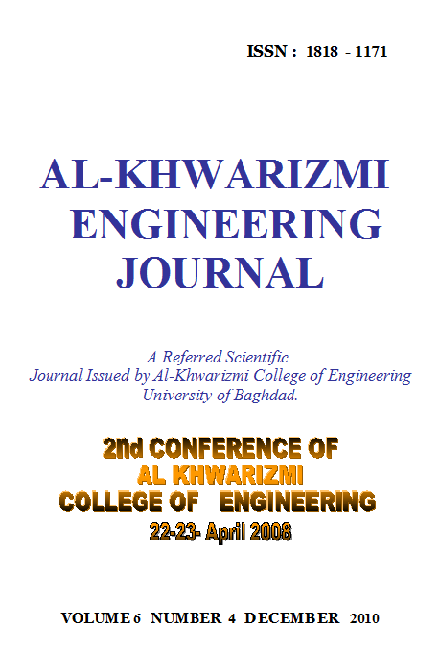Improvement of Surface Roughness Quality for Stainless Steel 420 Plate Using Magnetic Abrasive Finishing Method
Abstract
An experimental study was carried out to improve the surface roughness quality of the stainless steel 420 using magnetic abrasive finishing method (MAF). Four independent operation parameters were studied (working gap, coil current, feed rate, and table stroke), and their effects on the MAF process were introduced. A rotating coil electromagnet was designed and implemented to use with plane surfaces. The magnetic abrasive powder used was formed from 33%Fe and 67% Quartz of (250µm mesh size). The lubricant type SAE 20W was used as a binder for the powder contents. Taguchi method was used for designing the experiments and the optimal values of the selected parameters were found. An empirical equation representing the relation between surface roughness with operation parameters have been achieved.
Downloads
References
[2] Geeng-Wei Chang, Biing-Hwa, and Yan, Rong-Tzong Hsu, “Study on cylindrical magnetic abrasive finishing using unbounded magnetic abrasives”, International Journal of Machine Tools & Manufacture, Vol.42 (2002), pp. 575–583.
[3] T. Mori, K. Hirota, and Y. Kawashima, “Clarification of magnetic abrasive finishing mechanism”, Journal of Materials Processing Technology, Vols.143-144 (2003), pp. 682–686.
[4] 4- V. S. Maiboroda and E. A. Khomenko, “Tribotechnical characteristics of ferroabrasive powders in magnetic-abrasion machining”, Journal of Powder Metallurgy and Metal Ceramics, Vol.42 (2003), pp. 9-10.
[5] Dhirendra K. Singh, V.K. Jain, and V. Raghuram., “Parametric study of magnetic abrasive finishing process”, Journal of Materials Processing Technology, Vol.149 (2004), pp. 22–29.
[6] Y. M. Baron, S. L. Ko, and J. I. Park, “Characterization of the magnetic abrasive finishing method and its application to deburring”, Key Engineering Materials Vols.291-292 (2005), pp. 291-296.
[7] Yan Wang, and Dejin Hu, ”Study on the inner surface finishing of tubing by magnetic abrasive finishing”, International Journal of Machine Tools & Manufacture, Vol.45 (2005), pp. 43–49.
[8] O. V. Stepanova, I. V. Uvarova, V. P. Smirnov, I. I. Timofeeva, and A. A. Rogozinskaya, “Effect of magnetic abrasive finishing on the chemical and phase composition of Tic coating on VK8 alloy”, Journal of Powder Metallurgy and Metal Ceramics, Vol.44 (2005), pp. 9-10.
[9] P. I. Yascheritsin, L. E. Sergeev, and M. I. Sidorenko, “The comparative appraisal of quality characteristics of holes after different finishing methods”, Journal of Advanced Performance Materials, Vol.4 (1997), pp. 337–347.
[10] K. A. Gogaev, V. V. Nepomnyashchii, T. V. Mosina, I. P. Neshpor, and M. Leonowicz, “Special features of the magnetic abrasive machining”, Journal of Refractories and Industrial Ceramics, Vol.47, No.1 ( 2006), pp. 46-47.
[11] Ching-Tien Lin, Lieh-Dai Yang, and Han-Ming Chow, “Study of magnetic abrasive finishing in free-form surface operations using the Taguchi method”, International Journal of Advanced Manufacturing Technology, (2006).
[12] Dhirendra K. Singh, V. K. Jain, and V. Raghuram, “Experimental investigations into forces acting during a magnetic abrasive finishing process”, International Journal of Advanced Manufacturing Technology Vol.30 (2006), pp. 652–662.
[13] L. Ko, Yu M. Baron, and J.I. Park,”Micro deburring for precision parts using magnetic abrasive finishing method”, Journal of Materials Processing Technology Vols.187–188 (2007), pp. 19–25.
Published
Issue
Section
License
Copyright: Open Access authors retain the copyrights of their papers, and all open access articles are distributed under the terms of the Creative Commons Attribution License, which permits unrestricted use, distribution, and reproduction in any medium, provided that the original work is properly cited. The use of general descriptive names, trade names, trademarks, and so forth in this publication, even if not specifically identified, does not imply that these names are not protected by the relevant laws and regulations. While the advice and information in this journal are believed to be true and accurate on the date of its going to press, neither the authors, the editors, nor the publisher can accept any legal responsibility for any errors or omissions that may be made. The publisher makes no warranty, express or implied, with respect to the material contained herein.












